
The tabletop pasta maker had it’s first trial as a mobile printing press today. RESULT!!!!! It worked beautifully. It’s taken ages to renovate because we had stored it in a really damp cupboard and it was badly rusted, but WD40, patience and elbow grease did the job.
Here’s how I recycled it…………….
First, I cut a piece of Intaglio Printmaker’s paper drypoint etching plate and then I redrew a little drawing of a hare onto it, from one of my sketchbooks, using a Faber Castell Pitt drawing pen, size S. Thirdly, I scratched over the linework with my drypoint tool, just breaking the surface of the plastic coating. Then I cut and soaked some small pieces of Bockingford before removing the pen drawing with a very lightly dampened piece of cotton wool. Finally I cut some pieces of felted wool to be used as tiny blankets for the pasta press.
Inking up the drypoint plate ………..
I put a blob of Intaglio Printmaker’s Drypoint Mix oil–based etching ink onto my inking block (a recycled bit of marble from an old fireplace) and picked some up with a mini rubber squeegee. I squeegeed the ink across the little drypoint plate then removed the excess, firstly with the edge of an old business card and then with a piece of tissue paper, taking care not to take too much off. Finally I wiped the edges with a rag, cleaned my hands and blotted a piece of the soaked Bockingford paper.
Making a blanket sandwich …….
On top of one of the first blanket I laid a clean piece of tissue paper, then the blotted Bockingford and then placed the drypoint plate, inky side down, then another layer of tissue and finally the second blanket.
Taking the print ……..
I picked up the blanket sandwich very carefully and firmly, making sure none of the layers slipped and rested the bottom edge onto the rollers in the pasta press. I turned the handle with one hand while keeping a tight grip on the blanket sandwich with the other. Once it was through, I peeled away the layers and voila! A teeny little etching.
These paper drypoint plates make an edition of 10 or so etchings before wearing out. I think I might try some hand colouring on these little hares, with my Winsor & Newton Artist’s Watercolours.
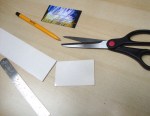


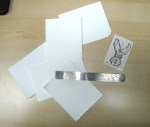
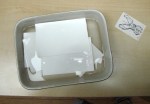
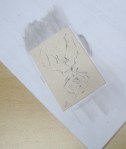
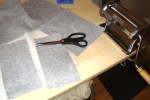

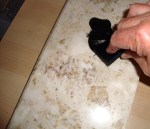
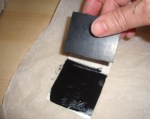
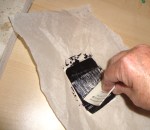
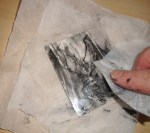
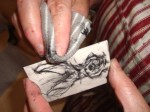
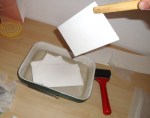
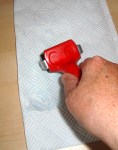






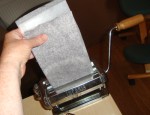


Neat-O!
Thank you 😀
I LOVE the recycled pasta maker! You made a Transformer. 🙂
I hope it doesn’t try to take over the world!!!!
Reblogged this on Press Genepy and commented:
Such a great idea … when I noticed a pasta machine on sale at Debenhams for £16 I knew it had to be done!
Oh yess!! That’s a good price. have you done any?
Such a great idea, and wonderful to see the steps. I have a pile of the drypoint card plates (presumably the same as you are using) that I bought ages ago … time to use them again!
Oh yes, do. It’s so easy compared to normal etching, or even drypoint on metal. I find that using Intaglio Printmaker’s own shop mix drypoint ink helps.
Hi nathalia, Im printmaking artist from Bangalore india, I like you’re print, as . Was also invited from ipep programme, due to busy in solo I could participate this time, I like post, be on contact I would any good opportunities in printmaking, im very passionate to continue my practice. Any where in the world
Now I need to find an old pasta maker! eBay! Something I could do at home.
Yes, there must be loads of unwanted ones around. We lost enthusiasm for making pasta after a couple of attempts and doing the printmaking was easier. It was less strenuous too.
yep,ditto.
There are not enough stars to like this post.
Thank you. I hope other people will try this 🙂
… I have a pasta maker
hehehehe ………..
Reblogged this on Not So Great Dictator Speaks With Words and commented:
Brilliant post by the Scribblah.
Thank you 🙂
Wow, I’m really impressed. It worked out so well. The hare is really lovely! Have a lovely weekend! 🙂
Thank you 🙂 I was surprised. I was expecting to have to do loads of adjusting and experimenting but it worked first time. Sending a heatwave your way
Super! I tried this with small solar plates a while back, with limited success. The metal plates printed “OK” but curled (bent) as they went thru the rollers. And I needed clever felt blankets like yours. But paper plates, now that’s brilliant! I haven’t seen paper drypoint plates here, ‘tho maybe very thin flexible plexiglass (perspex to you) would work, too.
I can just see you hauling your pasta machine, papers, and tools to the next community art event: drypoint! Drypoint for everyone!
Yes, I was worried that paper plates might curl although there is a plastic photopolymer plate available which is very flexible and some people online reckon that collagraphs can work as well.
Love it! So what block did you use? Looks like one of the soft cut style? Thanks for sharing all the photos. I bet there will be more folks watching out for pasta machines at the thrift shops. 😉
It’s a paper drypoint plate. I’m not sure that a block would go through. It’s surprising how bulky it gets with the blankets and paper 😀